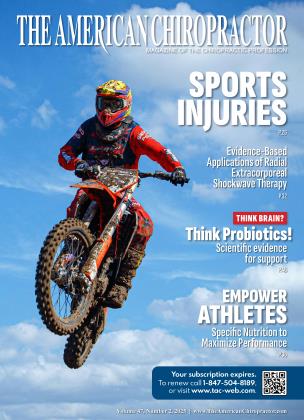Specific Nutrition to Maximize Performance
February 1 2025 Guy R. SchenkerSpecific Nutrition to Maximize Performance
February 1 2025 Guy R. Schenker
THE DIFFERENCE BETWEEN A SPORTS CHAMPION AND an also-ran is measured in inches and milliseconds, in aerobic and anaerobic efficiency, and in oxidative and glycolytic muscle fiber deployment. As a chiropractor, you have many means by which you can be a critical part of an athlete’s quest and then beam with pride from the sidelines as gold medals are presented.
Specific nutrition is your direct and simple way to give athletes a competitive edge. Nutrition gives you the capacity to:
1. “Turbocharge” muscle energy production by maximizing efficiency of aerobic vs. anaerobic, glycolytic vs. fatty acid, and glucose vs. lactic acid energetics.
2. Support muscle and connective tissue repair and remodeling.
3. Prevent fatigue-induced-injury.6
As an illustration of how you can give your athletes all three of these benefits, consider supplementation with 1-carnitine (LC) and its close cousin, acetyl-l-carnitine (ALC).
The primary function of LC is transporting fatty acids from the cytosol into the mitochondria during the breakdown of lipids for the generation of metabolic energy. In the mitochondrial matrix, fatty acids are broken down through P-oxidation to acetyl-CoA for energy from the citric acid cycle (CAC).
Fatty acids must bind to LC to form acylcarnitine (AC). Mitochondria are impermeable to fatty acyl-CoA but efficiently take in fatty acylcarnitine. Carnitine is essential for the translocation of long-chain fatty acids into skeletal muscle mitochondria for P-oxidation, which, in turn, feeds acetyl-CoA into the CAC.8
A review of all studies on LC supplementation using healthy human subjects daily for 24 weeks shows that supplementation effectively elevates total LC content in skeletal muscle. Carnitine supplementation augments exercise performance in athletes. It increases maximal oxygen consumption and decreases respiratoiy quotient, indicating that LC has the potential to stimulate lipid metabolism,—
With its pivotal role in fatty acid oxidation and energy metabolism, LC is an extremely effective ergogenic aid in enhancing exercise capacity. Research over many years indicates its beneficial effects on athletic performance, as objectively shown by its increasing maximum oxygen consumption and yielding higher power output.
Recent studies also show LC supplementation enhances the recovery process after exercise. Carnitine alleviates muscle injury and reduces markers of cellular damage and free radical formation, which decreases muscle soreness. Supplementation to increase muscle LC content enhances blood flow and oxygen supply to the muscle tissue via improved endothelial function, thereby reducing hypoxia-induced cellular and biochemical disruptions.2
Looking beyond its benefits in sports competition, it has been shown that LC in older adults will increase muscle mass, accompanied by a decrease in body weight and reduced physical and mental fatigue. Research suggests a role for LC in the prevention of age-associated muscle protein degradation with improved regulation of mitochondrial energy production.2
Carnitine induces a significant post-exercise decrease in plasma lactate, which is formed and used continuously under fully aerobic conditions. Carnitine limits the deleterious effects of hypoxic training and speeds up recovery from exercise stress. Carnitine plays a decisive role in the prevention of cellular damage and favorably affects recovery from exercise stress.1-5
“Trained athletes have a higher capacity to utilize fatty acids during exercise and appear to have a higher total muscle LC content compared to untrained controls”
Increasing muscle total LC content alleviates the decline in fat oxidation rates routinely observed during high-intensity exercise and concomitantly reduces muscle glycogen utilization. Trained athletes have a higher capacity to utilize fatty acids during exercise and appear to have a higher total muscle LC content compared to untrained controls. Increasing skeletal muscle LC content delays fatigue development by 25% during electrical muscle stimulation.8
During strenuous exercise, a large portion of LC and unused acetyl-CoA are converted to ALC and Co A inside mitochondria. The ALC is transported outside the mitochondria, where it converts back to LC and acetyl-CoA. The LC is cycled back into the mitochondria with acyl groups to facilitate fatty acid utilization.
Following a few minutes of high-intensity exercise, skeletal muscle LC content is reduced from 75% of the total muscle LC pool at rest to around 20%, with almost all the reduction being attributed to the formation of ALC. This increase in ALC formation during high-intensity exercise occurs to a greater extent in type I muscle fibers.
It is directly related to the increase in muscle acetyl-CoA, suggesting that the rate of acetyl-CoA formation from pyruvate oxidation exceeds its utilization by the CAC cycle, leading to excess accumulation of acetyl-CoA. Thus, during high-intensity exercise, LC buffers the excess acetyl groups formed, ensuring a viable pool of free Co-A-SH to be maintained for the continuation of the CAC. 5
In addition to maintaining a viable pool of Co-A-SH, the accumulation of ALC itself provides a store of acetyl groups, which is readily available for transacetylation back to its acetyl-CoA for utilization by the CAC cycle. So, in the latter half of four hours of exercise at 55% V02max, muscle ALC content returns to near resting values. ALC is the acetyl derivative of LC that possesses slight cholinergic-mimetic activity. Its success in sports medicine depends largely on its ability to stimulate CNS functions.
Carnitine action during exercise is mediated by catecholamines. Blood samples of soccer players after a game showed a remarkable decrease in antioxidant status and LC levels. Total acyl-Carnitine and catecholamine levels (adrenaline and noradrenaline) were significantly increased.
“Carnitine’s role in workout recovery and minimizing tissue damage from sports injuries is partly mediated via its antiinflammatory benefits”
There was a significant inverse correlation between adrenaline and free Carnitine, and a positive correlation between adrenaline and total acyl-Carnitine, indicating that sympathetic stimulation activates LC functions to the point of depleting LC.10
Carnitine-supplemented participants performed four sets of 15 repetitions of squat/leg press at 50%, with one-repetition maximum. Blood samples before, during, and after exercise and during four days of recovery showed that LC supplementation had positive effects and significantly attenuated biochemical markers of purine metabolism,s free radical formation, muscle tissue disruption, and muscle soreness after physical exertion. In summary, LC supplementation can reduce chemical damage to tissues from exercise and optimize the process of muscle tissue repair and remodeling.14
Carnitine’s role in workout recovery and minimizing tissue damage from sports injuries is partly mediated via its anti-inflammatory benefits. LC has similar immunomodulatory effects as glucocorticoids. Carnitine suppresses the release of TNF-a and interleukin-12 from human monocytes while it activates glucocorticoid receptors. Furthermore, this suppression of excess inflammatory cytokines is blocked by administering a glucocorticoid inhibitor, showing that at least part of carnitine’s immunomodulatory benefits is from potentiating the anti-inflammatory effects of glucocorticoids.7
Your empowerment of athletes with LC and ALC supplementation is fully achieved with smaller doses given consistently over time and in combination with other nutrients that work synergistically to promote mitochondrial energy production and training recovery. These synergists include lipoic acid, betaine, carnosine, and chondroitin.
For example, lipoic acid and ALC are two mitochondrial energy enhancers. Most notably, it has been found that combining lipoic acid and ALC works at 100 to 1,000 fold lower concentrations than they do individually. Pretreatment with combined lipoic acid and ALC increases mitochondrial biogenesis and decreases production of reactive oxygen species. 3
Athletic performance enhancement, accelerated workout recovery, faster and more complete injury recovery, and fatigue-induced injury prevention are all within your capacity. Simply, immediately, and without major capital invested, you can empower athletes with specific nutrition supplementation.

Guy R. Schenker, DC, is the founder of NUTRI-SPEC, which has served chiropractors and other healthcare professionals interested in clinical nutrition since 1984. NUTRI-SPEC offers metabolic testing procedures, that help determine the specific metabolic imbalances underlying each individual patient’s symptomatic complaints. NUTRI-SPEC provides supplement formulations specifically designed to meet the needs of those metabolic imbalances. He can be contacted at NUTRI-SPEC at (800) 736-4320 and at [email protected]. For more info go towww.nutri-spec.net.
8. Mielgo-Ayuso J, Pietrantonio L, Viribay A, Calleja-Gonzalez J, Gonzalez-Bernal J, Fernandez-Lazaro D. Effect of acute and chronic oral 1-carnitine supplementation on exercise performance based on the exercise intensity: a systematic review. Nutrients. 2021 Dec 3;13(12):4359. doi: 10.3390/nul3124359. PMID: 34959912; PMCID: PMC8704793.
1. Caballero-Garcia A, Noriega-Gonzalez DC, Roche E, Drobnic F, Cordova A. Effects of 1-carnitine intake on exercise-induced muscle damage and oxidative stress: a narrative scoping review. Nutrients. 2023 May 31;15(11):2587. doi: 10.3390/nul5112587. PMID: 37299549; PMCID: PMC10255885.
2. Fielding R, Riede L, Lugo JP, Bellamine A. 1-carnitine supplementation in recovery after exercise. Nutrients. 2018 Mar 13; 10(3): 349. doi: 10.3390/nul0030349. Erratum in: Nutrients. 2018 Apr 26;10(5):E541. doi: 10.3390/nul0050541. PMID: 29534031; PMCID: PMC5872767.
3. Zhang H, Jia H, Liu J, Ao N, Van B, Shen W, Wang X, Li X, Luo C, Liu J. Combined R-alpha-lipoic acid and acetyl-L-carnitine exerts efficient preventative effects in a cellular model of Parkinson’s disease. J Cell Mol Med. 2010 Jan;14(l-2):215-25. doi: 10.1111/j.l5824934.2008.00390.x. PMID: 20414966; PMCID: PMC3837594.
4. Ho JY, Kraemer WJ, Volek JS, Fragala MS, Thomas GA, Dunn-Lewis C, Coday M, Hakkinen K, Maresh CM. 1-Carnitine 1-tartrate supplementation favorably affects biochemical markers of recovery from physical exertion in middle-aged men and women. Metabolism. 2010 Aug;59(8): 1190-9. doi: 10.1016/j.metabol.2009.11.012. Epub 2009 Dec 31. PMID: 20045157.
5. Karlic H, Lohninger A. Supplementation of L-carnitine in athletes: does it make sense? Nutrition. 2004 Jul-Aug;20(7-8):709-15. doi: 10.1016/j.nut.2004.04.003. PMID: 15212755.
6. Kellmann M. Preventing overtraining in athletes in high-intensity sports and stress/recovery monitoring. Scand J Med Sci Sports. 2010 Oct;20 Suppl 2:95-102. doi: 10.1111/j. 1600-0838.2010.01192.x. PMID: 20840567.
7. Manoli I, De Martino MU, Kino T, Alesci S. Modulatory effects of 1-carnitine on glucocorticoid receptor activity. Ann NY Acad Sci. 2004 Nov;1033:147-57. doi: 10.1196/annals. 1320.014. PMID: 15591012.
9. Sawicka AK, Renzi G, Olek RA. The bright and the dark sides of L-camitine supplementation: a systematic review. J Int Soc Sports Nutr. 2020 Sep 21;17(1):49. doi: 10.1186/sl2970-020-00377-2. PMID: 32958033; PMCID: PMC7507632.
10. Schulpis KH, Parthimos T, Papakonstantinou ED, Tsakiris T, Parthimos N, Mentis AF, Tsakiris S. Evidence for the participation of the stimulated sympathetic nervous system in the regulation of carnitine blood levels of soccer players during a game. Metabolism. 2009 Aug;58(8): 1080-6. doi: 10.1016/j.metabol.2009.04.001. Epub 2009 Jun 18. PMID: 19428035.
 View Full Issue
View Full Issue






